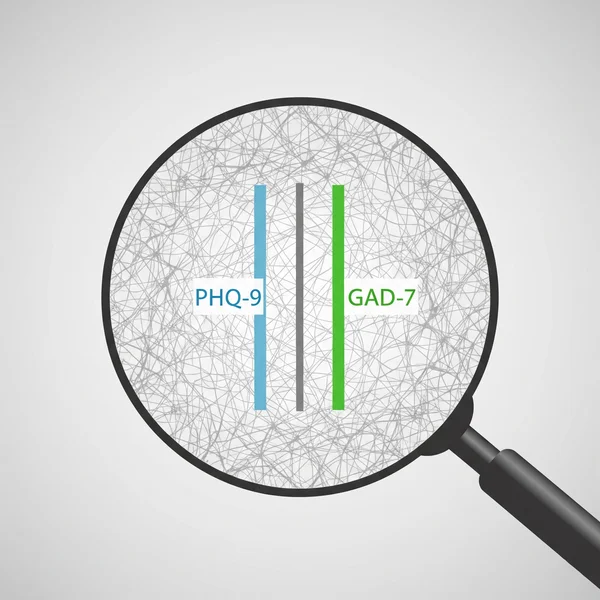PHQ-9 vs GAD-7: A Guide to Depression & Anxiety Screening
Do you ever feel a heavy sense of sadness, while at the same time your mind is racing with worry? You're not alone. The lines between feeling depressed and feeling anxious can often seem blurry, making it difficult to understand what's really going on. So, what is the difference between PHQ-9 and GAD-7, the two most common tools used to shed light on these feelings? This guide will demystify these powerful screening tools, explaining what they are, how they differ, and why they are often used together. Understanding these tools is the first step toward gaining clarity about your mental wellness. To begin your journey of self-understanding, you can explore a confidential and validated assessment on our platform.

What is the PHQ-9? A Focus on Depression
The Patient Health Questionnaire-9 (PHQ-9) is a highly respected and widely used self-assessment tool designed specifically for depression screening. It consists of nine questions that directly correspond to the diagnostic criteria for major depressive disorder found in the DSM-5, the standard classification manual for mental health professionals.
The questions explore core symptoms of depression experienced over the past two weeks, including:
- Persistent low mood or sadness
- Loss of interest or pleasure in activities (anhedonia)
- Changes in sleep or appetite
- Feelings of worthlessness or guilt
- Difficulty concentrating
The final score helps quantify the severity of depressive symptoms, providing a valuable starting point for a conversation with a healthcare provider.
What is the GAD-7? The Standard for Anxiety Screening
On the other side of the coin is the Generalized Anxiety Disorder-7 (GAD-7). As its name suggests, this seven-question tool is the gold standard for screening for generalized anxiety disorder (GAD). It assesses the severity of common anxiety symptoms over the last two weeks.
The GAD-7 focuses on symptoms like:
- Feeling nervous, anxious, or on edge
- Not being able to stop or control worrying
- Trouble relaxing
- Becoming easily annoyed or irritable
- Feeling afraid as if something awful might happen
Similar to the PHQ-9, the GAD-7 provides a score that indicates the severity of anxiety, from minimal to severe. Many people wonder which test they should take, and the answer often depends on their primary symptoms.
Key Differences: PHQ-9 vs. GAD-7 Side-by-Side
While both are valuable clinical tools, their focus is distinct. Understanding their differences is crucial for proper scoring interpretation. Here’s a direct comparison:

| Feature | PHQ-9 | GAD-7 |
|---|---|---|
| Primary Target | Major Depressive Disorder | Generalized Anxiety Disorder |
| Number of Questions | 9 | 7 |
| Core Symptom Focus | Mood, interest, self-worth, sleep | Worry, nervousness, restlessness |
| Example Question | "Feeling down, depressed, or hopeless" | "Feeling nervous, anxious or on edge" |
This side-by-side view makes it clear: the PHQ-9 is your go-to for understanding depressive symptoms, while the GAD-7 is tailored for anxiety.
Why Are They Often Used Together? The Power of Comorbidity
So, can I have both depression and anxiety? Absolutely. In the world of mental health, this overlap is known as comorbidity, and it's incredibly common. Depression and anxiety often go hand-in-hand, with one condition frequently triggering or worsening the other.
Because of this high rate of comorbidity, clinicians often administer the gad 7 and phq 9 together. This dual approach provides a more comprehensive and holistic view of a person's mental state. It helps distinguish between the two conditions and identifies individuals who may be struggling with both, ensuring a more accurate treatment plan. A complete PHQ-9 assessment is an excellent first step in this process.
How to Interpret Combined PHQ-9 and GAD-7 Scores
Receiving a high phq 9 and gad 7 score can feel overwhelming, but it's important to know what it means. It doesn't automatically mean you have two separate, severe disorders. Rather, it's a strong indicator of significant emotional distress that requires attention.
Here's the most important takeaway: these scores are signals, not diagnoses. They are designed to start a conversation. The best course of action is to share these results with a doctor or mental health professional. They can conduct a thorough evaluation, consider the full context of your life, and provide an accurate diagnosis and personalized guidance.
Two Tools, One Goal: A Clearer Picture of Your Mental Health
Ultimately, the phq 9 vs gad 7 debate isn't about choosing a winner. They are partners in the journey toward mental wellness. These tools empower you with objective information, transforming vague feelings of "not being okay" into concrete data that you can act on. They provide the vocabulary and the confidence to seek professional help.
Frequently Asked Questions
Are PHQ-9 and GAD-7 diagnostic tools?
No, this is a critical distinction. The PHQ-9 and GAD-7 are highly effective screening tools, not diagnostic tools. A diagnosis can only be made by a qualified healthcare professional after a comprehensive evaluation. Think of them as a thermometer for mental health—they tell you if you have a fever, but not what's causing it.
Which test should I take first, PHQ-9 or GAD-7?
There is no strict rule. If your primary concern is persistent sadness and loss of interest, starting with the PHQ-9 makes sense. If uncontrollable worry is your main issue, begin with the GAD-7. However, because the symptoms often overlap, many professionals recommend taking both. You can begin by understanding your depression symptoms with the free and reliable PHQ-9 test.
What does a high score on both tests mean?
A high score on both indicates a significant level of distress related to both depressive and anxious symptoms. It's a strong signal that your mental well-being is being seriously impacted. This is not something to ignore. It is a clear and compelling reason to schedule an appointment with a doctor or therapist to discuss the results and explore next steps.